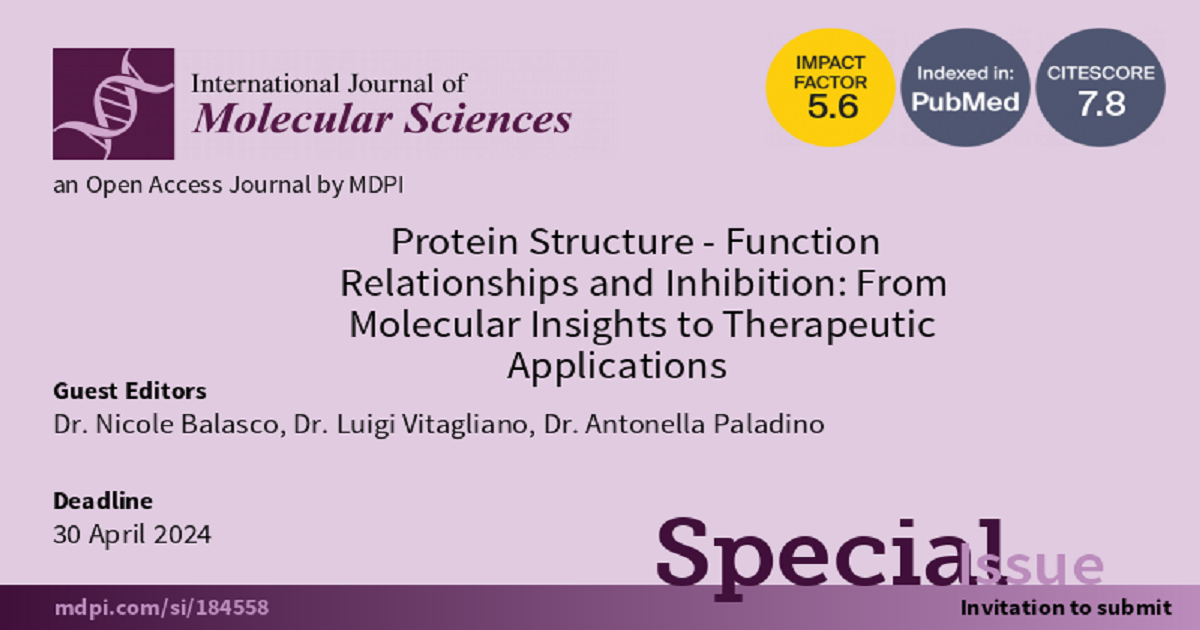Protein Structure-Function Relationships and Inhibition: From Molecular Insights to Therapeutic Applications
A special issue of International Journal of Molecular Sciences (ISSN 1422-0067). This special issue belongs to the section "Molecular Pharmacology".
Deadline for manuscript submissions: closed (30 April 2024) | Viewed by 419

Special Issue Editors
Interests: protein structure–function; molecular modeling; molecular dynamics; molecular interactions; computational biology; structural biology
Special Issues, Collections and Topics in MDPI journals
Interests: protein structure–function; molecular dynamics; computational biology; structural biology; molecular basis of diseases; biophysics
Special Issues, Collections and Topics in MDPI journals
Interests: computational biology and chemistry; structural modeling; molecular dynamics; docking; PPI; molecular interactions; protein structure/function
Special Issues, Collections and Topics in MDPI journals
Special Issue Information
Dear Colleagues,
Proteins are central players in all biological processes. A fundamental paradigm of structural biology assumes that the functionality of these macromolecules is strictly related to their three-dimensional structures. In this scenario, the understanding of protein structures is a prerequisite for modulating their activities and for developing new therapeutic agents targeting these giant biomolecules. The acquisition of atomic-level structural information about proteins is also fundamental for their modulation. For decades, this task has been extremely difficult due to the complex and time-consuming methodologies utilized to obtain experimental structural data. Very recently, the introduction of effective machine-learning-based approaches, such as Alpha Fold, has provided accurate structural information about proteins, starting from their amino acid sequences. This represents an extremely useful tool for the development of novel molecular entities aimed at enhancing or impairing protein functions.
We encourage the submission of original contributions, short communications, or review articles that describe the development and application of computational and experimental structural biology techniques in order to foster drug development and optimization.
Dr. Nicole Balasco
Dr. Luigi Vitagliano
Dr. Antonella Paladino
Guest Editors
Manuscript Submission Information
Manuscripts should be submitted online at www.mdpi.com by registering and logging in to this website. Once you are registered, click here to go to the submission form. Manuscripts can be submitted until the deadline. All submissions that pass pre-check are peer-reviewed. Accepted papers will be published continuously in the journal (as soon as accepted) and will be listed together on the special issue website. Research articles, review articles as well as short communications are invited. For planned papers, a title and short abstract (about 100 words) can be sent to the Editorial Office for announcement on this website.
Submitted manuscripts should not have been published previously, nor be under consideration for publication elsewhere (except conference proceedings papers). All manuscripts are thoroughly refereed through a single-blind peer-review process. A guide for authors and other relevant information for submission of manuscripts is available on the Instructions for Authors page. International Journal of Molecular Sciences is an international peer-reviewed open access semimonthly journal published by MDPI.
Please visit the Instructions for Authors page before submitting a manuscript. There is an Article Processing Charge (APC) for publication in this open access journal. For details about the APC please see here. Submitted papers should be well formatted and use good English. Authors may use MDPI's English editing service prior to publication or during author revisions.
Keywords
- protein structure determination
- protein folding
- protein function–structure relationships
- protein function modulation
- protein structure–stability
- protein structure predictions
- structure-based drug design (SBDD)
- drug optimization








